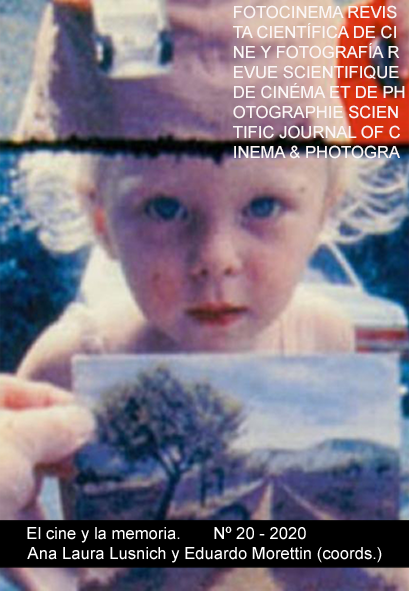Labyrinths of remembrance. The representation of memory in Eternal Sunshine of the Spotless Mind
DOI:
https://doi.org/10.24310/Fotocinema.2020.v0i20.7601Keywords:
Memory, memory film, narratology, subjectivity, temporary indiscernibility, performativityAbstract
The article proposes a study of the film Eternal Sunshine of the Spotless Mind as a paradigmatic case of "memory film". The film, directed by Michel Gondry and written by Charlie Kaufman, addresses the filmic representation of personal memory in an accomplished way, in its double condition of object and process. The analysis first deals with how memory emerges in the film as its thematic axis. Then the structure of the story is analyzed, built with different narrative lines that constantly intersect and that cause an obvious narratological complexity. Finally, the three most characteristic features of memory films are addressed: subjectivity, temporal indiscernibility and performativity. The way in which these three features converge on Eternal Sunshine of the Spotless Mind makes this film an excellent example of the possibilities available in cinema for the representation of personal memory.
Downloads
Metrics
Publication Facts
Reviewer profiles N/A
Author statements
Indexed in
-
—
- Academic society
- N/A
- Publisher
- Universidad de Málaga
References
Bergson, H. (1946), The Creative Mind: An Introduction to Metaphysics. New York: Citadel Press.
Buckland, W. (2009). Puzzle Films: Complex Storytelling in Contemporary Cinema. Chichester: Wiley-Blackwell.
Campora, M. (2009). Art cinema and New Hollywood: Multiform narrative and sonic metalepsis in Eternal Sunshine of the Spotless Mind. New Review of Film and Television Studies, 7 (2), 119-131.
Ciancio, M. B. (2013). Labyrinths and Lines of Memory in Documentary Film. Memoria del saqueo and Los rubios from a Philosophical Perspective. Latin American Perspectives, 40 (1), 101-113.
Cuevas, E. (2001). Focalización de los relatos audiovisuales. Trípodos, 11, 123-136.
Cuevas, E. (2009). La narratología audiovisual como método de análisis. Portal de la Comunicación, 1-12. http://www.portalcomunicacion.com/uploads/pdf/53_esp.pdf
Day, W. (2011). I Don’t Know, Just Wait: Remembering Remarriage in Eternal Sunshine of the Spotless Mind. En D. Larocca (ed.), The Philosophy of Charlie Kaufman (pp. 132-154). Lexington: University Press of Kentucky.
Deleuze, G. (1987). La imagen-tiempo: Estudios sobre cine II. Barcelona: Paidós.
Deleuze, G. (1991). La imagen-tiempo: Estudios sobre cine I. Barcelona: Paidós.
Del Rincón, M., Torregrosa, M., Cuevas, E. (2017). La representación fílmica de la memoria personal: las películas de memoria. ZER, 22 (42), 175-188. DOI: 10.1387/zer.17842
Dzialo, C. (2009). Frustrated Time Narration: the Screenplays of Charlie Kaufman. En W. Buckland (ed.), Puzzle Films: Complex Storytelling in Contemporary Cinema (pp. 107-128). Chichester: Wiley-Blackwell.
Erll, A. (2011). Memory in Culture. Chippenham and Eastbound: Palgrave Macmillan.
García-Sahagún, M (2016). La crisis de la identidad personal en el protagonista del cine contemporáneo (Tesis doctoral). Universidad Complutense de Madrid https://eprints.ucm.es/44286/1/T39119.pdf
Gaudreault, A., Jost, F. (1995). El relato cinematográfico. Cine y narratología. Barcelona: Paidós.
Genette, G. (1989). Figuras III. Barcelona: Lumen.
Genette, G. (2004). Metalepsis. De la figura a la ficción. Buenos Aires: Fondo de Cultura Económica.
Grass, M. (2009). Imagen latente y Los rubios: Performatividad cinematográfica y estética de la memoria en el cine latinoamericano (Tesis Doctoral, Universidad de Chile), Recuperado de http://repositorio.uchile.cl/tesis/uchile/2009/grass_m/html/index-frames.html
Jost, F. (1989). L'Oeil-caméra. Entre film et roman. 2ª ed. revisada y aumentada. Lyon: Presses Universitarires de Lyon.
Kilbourn, R. J. A. (2012). Cinema, Memory, Modernity: The representation of Memory from the Art Film to Transnational Cinema. Nueva York: Routledge.
Kiss, M. (2012). Navigation in Complex Films: Real-life Embodied Experiences Underlying Narrative Categorisation. En J. Eckel, B. Leiendecker, D. Olek (eds.), (Dis)Orienting Media and Narrative Mazes (pp. 237-251). Bielefeld: Transcript.
MacDougall, D. (1992). Films of Memory. Visual Anthropology Review, 8 (1), 29-37.
MacDougall, D. (1998). Films of Memory. En D. MacDougall (ed.), Transcultural Cinema (pp. 231-244). Princeton: Princeton University Press.
Murray, J. H. (1997). Hamlet on the Holodeck: The Future of Narrative in Cyberspace. Nueva York: Free Press.
Piggot, M. (2009). Manifesting a Mutant Past in Eternal Sunshine of the Spotless Mind. En C. Lee (ed.), Violating time: History, Memory and Nostalgia y Cinema (pp. 170-190). Nueva York: Continuum.
Rawle, S. (2012). Reconstructing the Past: Visual Virtuality in Eternal Sunshine of the Spotless Mind. En A. Shinha, T. McSweeney (eds.), Millennial Cinema: Memory in Global Film (pp. 37-54). Londres y Nueva York: Wallflower Press.
Sperb, J. (2005). Internal Sunshine: Illuminating Being-Memory in Eternal Sunshine of the Spotless Mind. Kritikos, 2. https://intertheory.org/sunshine.htm
Vidal, F. (2007). Eternal Sunshine of the Spotless Mind and the cultural history of the self. WerkstattGeschichte, 16 (45), 96-109.
Downloads
Published
How to Cite
Issue
Section
License
All contents published in Fotocinema Revista científica de cine y fotografía are protected under the Creative Commons Attribution-NonCommercial-ShareAlike 4.0 International (CC BY-NC-SA 4.0) license. All about this license is available in the following link: <http://creativecommons.org/licenses/by-nc-sa/4.0>
Users can copy, use, redistribute, share and exhibit publicly as long as:
- The original source and authorship of the material are cited (Journal, Publisher and URL of the work).
- It is not used for comercial purposes.
- The existence of the license and its especifications are mentioned.
There are two sets of authors’ rights: moral and property rights. Moral rights are perpetual prerogatives, unrenounceable, not-transferable, unalienable, imprescriptible and inembargable. According to authors’ rights legislation, Fotocinema. Revista científica de cine y fotografía recognizes and respects authors moral rights, as well as the ownership of property rights, which will be transferred to University of Malaga in open access. The property rights are referred to the benefits that are gained by the use or the dissemination of works. Fotocinema. Revista científica de cine y fotografía is published in an open access form and it is exclusively licenced by any means for doing or authorising distribution, dissemination, reproduction, , adaptation, translation or arrangement of works.
Authors are responsable for obtaining the necessary permission to use copyrighted images.














13.png)



